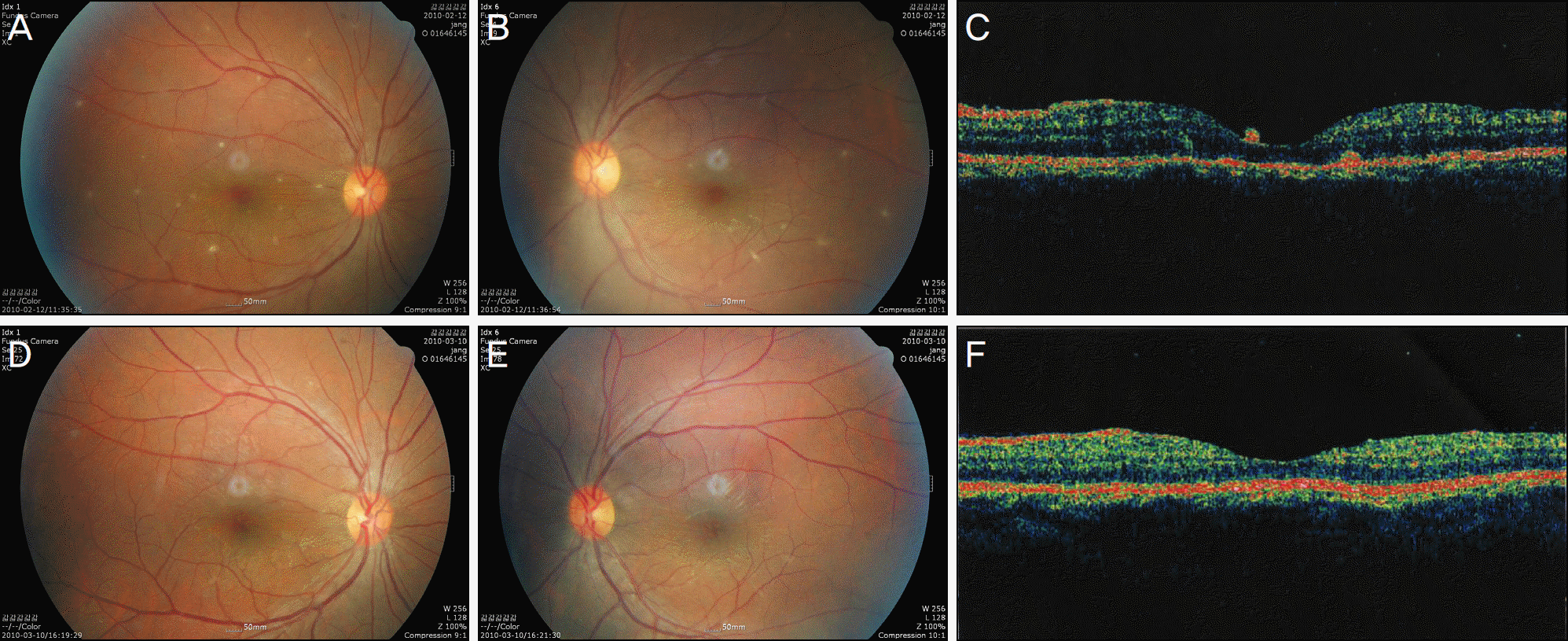Abstract
Purpose
To report clinical features and optical coherence tomographic findings of presumed atypical ocular tuberculosis associated with tuberculosis lymphadenitis and encephalomeningitis.
Case summary
A 28-year-old female with lymphadenitis in the axillary area presented with a fever and headache of a one week duration. CSF study and MRI findings implied tuberculosis encephalomeningitis, and presumed tuberculosis uveitis manifested with visual disturbance after five days. Ocular symptoms were aggravated and showed anterior iridocyclitis, vitritis, macular edema, and multifocal retinitis with miliary granuloma that was distinct from choroiditis or typical tuberculosis granuloma. After the patient received anti-tuberculosis medication and systemic corticosteroids, significant improvements in visual acuity, ocular findings and OCT results were observed.
Conclusions
Ocular tuberculosis can present with various clinical findings, and caution should be taken so as not to mis-diagnose based on these characteristics. In the present case, anti-tuberculosis medication and systemic steroids resulted in the resolution of inflammation. In such cases, monitoring the posterior pole lesion via OCT may be helpful in determining improvement.
Go to : 
References
2. Sheu SJ, Shyu JS, Chen LM, et al. Ocular manifestations of tuberculosis. Ophthalmology. 2001; 108:1580–5.

3. Moon S, Son J, Chang W. A case of oculomotor nerve palsy and choroidal tuberculous granuloma associated with tuberculous meningoencephalitis. Korean J Ophthalmol. 2008; 22:201–4.

4. Vasconcelos-Santos DV, Zierhut M, Rao NA. Strengths and weak-nesses of diagnostic tools for tuberculous uveitis. Ocul Immunol Inflamm. 2009; 17:351–5.

5. Gupta A, Bansal R, Gupta V, et al. Ocular signs predictive of tubercular uveitis. Am J Ophthalmol. 2010; 149:562–70.

6. Suzuki J, Oh-I K, Kezuka T, et al. Comparison of patients with ocular tuberculosis in the 1990s and the 2000s. Jpn J Ophthalmol. 2010; 54:19–23.

7. Sinha MK, Garg RK, Anuradha HK, et al. Vision impairment in tuberculous meningitis: predictors and prognosis. J Neurol Sci. 2010; 15:27–32.

8. Mehta S. Fundus fluorescein angiography of choroidal tubercles: case reports and review of literature. Indian J Ophthalmol. 2006; 54:273–5.

Go to : 
 | Figure 1.Fundus photographs of the both eyes. There are multiple white lesions presumed to miliary tuberculoma in the retinal area. |
 | Figure 2.Flurescein angiography showed atypical diffuse minimal capillary leaking in the late phase, and there was no hyperfluorescence on the tubercle. |
 | Figure 3.Ocular coherence tomography (OCT) showed small tubercula granuloma like lesion located anywhere from pre-retina to sub-retina that was distinctive feature from other choroid tuberculoma. |
 | Figure 4.‘A’ and ‘B’ are the photographs of fundus about 1 week after antituberculous medication and systemic steroid therapy. ‘C’ is their OCT finding. ‘D’ and ‘E’ are photographs of fundus about 1 month later, and ‘F’ is their OCT finding respectively. These photogaphs showed improvement of the lesions as time goes on. |




 PDF
PDF ePub
ePub Citation
Citation Print
Print


 XML Download
XML Download